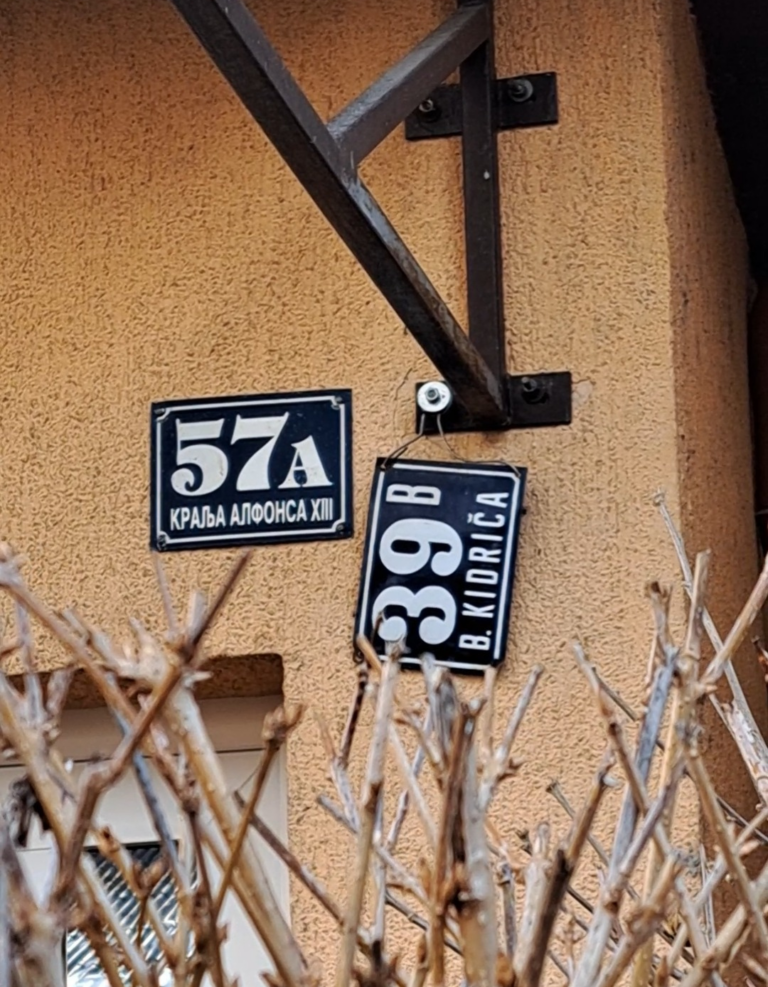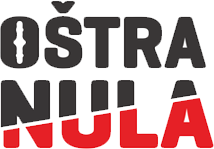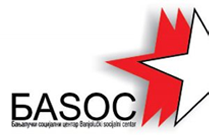Changes to Street Names
During the war in Bosnia and Herzegovina from 1992 to 1995, more than 75,000 non-Serb citizens were expelled from Banja Luka, a city that remained outside the zone of active warfare. Between 1993 and 1995, 16 mosques, the Sahat kula (Clock Tower), and numerous cultural monuments that testified to the centuries-long presence of Bosniaks/Muslims in the city were destroyed. During the same period, the Catholic monastery and church in Petrićevac were bombed, and the church in Presnače was set on fire.
In this way, the authorities of the Bosnian Serbs carried out not only mass ethnic cleansing in Bosnia’s second-largest city but also a form of cultural genocide.
Or, as stated by András Riedlmayer, a bibliographer at the Fine Arts Library of Harvard University:
“The unnecessary and deliberate destruction of cultural heritage is a crime that stems from the desire not only to kill individuals who are part of an ethnic or religious group but also to erase their very existence”.
And this is how it started
The introduction to cultural destruction and mass ethnic cleansing began with the effective and thorough renaming of streets and neighborhoods. With the support of the leadership of the Autonomous Region of Krajina, the Mayor of Banja Luka, Predrag Radić, and the President of the Executive Committee, Rajko Kasagić, the task of renaming was entrusted to a special commission. Among its members were Predrag Gugo Lazarević, a professor at the Pedagogical Academy, journalist Miro Mlađenović, and the self-proclaimed “promoter of Svetosavlje”, Nikola Guzijan.
It is important to recall that, until 1991, Banja Luka had 81 streets named after prominent figures from the Bosniak community, 114 from the Serb community, and 55 from the Croat community, while 153 streets bore the names of individuals from other ethnic groups or foreign historical and notable figures.
Fuad Balić, the first president of the Organizational Committee of the Community of Citizens’ Associations of Banja Luka, who has since passed away, reminded the public during a debate in 2007 that during 1992 and the following period, a complete urbicide took place in this regard. As a result, 333 streets were renamed after Serbs, only three after Bosniaks, and around a hundred streets were named after members of other ethnic groups.
The first initiative to revert the names of Banja Luka’s streets, squares, and neighborhoods to their original names was submitted to the relevant city authorities in 2003. However, 19 years later, no changes have been made.
“Comparing the street names before 1992 with the current situation, even without extensive analysis, two conclusions inevitably arise: first, that many anti-fascist fighters and national heroes from the People’s Liberation War (1941–1945) were unjustifiably erased from the new street name nomenclature; and second, that many streets and parts of the city now bear the names of individuals who have no connection to the history and development of the city, while many deserving historical figures and citizens from the fields of culture, education, art, anti-fascist struggle, and public service have been forgotten.
Some of the new names can be said to deviate from the democratic and libertarian traditions of Banja Luka”, emphasized Balić.
Ignoring Citizens’ Demands
Apart from the fact that most streets today bear names with no historical connection to Banja Luka, Bosnia and Herzegovina, or Bosnian Serbs, there is also a political dimension to this issue. According to the Constitution of the Republic of Srpska, Bosniaks, Croats, and Serbs are equal as constituent peoples in Bosnia and Herzegovina, including at the entity level. Therefore, the names of streets, squares, and neighborhoods should reflect this multiethnic character. The question remains why significant figures from other ethnic groups have been erased from the city’s and the country’s history.
During the aforementioned public debate in 2007, the late Slobodan Popović, who at the time was the vice president of the SDP BiH, stated that it was “shameful that this issue is being reopened in 2007, while every city administration keeps making promises but lacks both the political will and genuine readiness for change”.
“The renaming of streets occurred in a time that was nationalist, chauvinistic, and destructive to the city, and even today, apart from declarative statements, no one is showing a real willingness to change anything”, Popović warned, adding that “Europe is founded on the principles of anti-fascism, while Banja Luka has renounced every single anti-fascist who ever lived in this area”.
From the same debate, a particularly cynical statement came from Zdravko Josipović, who, speaking on behalf of the Banja Luka City Assembly, claimed that “there is a multiethnic commission responsible for addressing this issue, and it is not true that there is no willingness to discuss the renaming of streets. Rather, it is a very complex procedure, as everyone today has the right to raise this issue, and all initiatives must be considered and analyzed in terms of setting criteria for street name changes”.
According to local authorities in Banja Luka, out of a total of 466 streets, the names of 277 have been changed. However, Josipović pointed out that a bigger issue is the fact that 155 streets in the neighborhoods of Lauš, Šargovac, and Kuljani have no names at all, and that addressing this matter will take priority.
One particularly curious aspect of this process is the fact that, during the war years, when the commission responsible for renaming streets and neighborhoods in Banja Luka ran out of suitable Serbian heroes, writers, and artists from past centuries and wars, streets began to be named after fictional characters from literature. For instance, one street was named after Simeun Đak, a character from a short story by Petar Kočić, and there is no shortage of mythical figures from Serbian folk poetry, especially those associated with the Kosovo battle cycle.
Further evidence of the effort to erase any trace of Banja Luka’s historical origins and development can be seen in the renaming of toponyms, including settlements and even oronyms, such as hills and elevations.
Although the history of Banja Luka’s urban development is tied to the arrival of the Ottoman Empire in the area of present-day Bosnia and Herzegovina, specifically to the 16th century and the construction of the settlements Gornji and Donji Šeher, in 1992, Gornji Šeher was renamed to Srpske Toplice, presumably because of the healing water spas located there. However, since “banjas” sounded too Turkish, they were replaced with “toplice” (another term for spas). Then, as if in some theater of ignorance or a kind of irony, the hill above Gornji Šeher, or Srpske Toplice, was renamed Banj Brdo.
Citizens were never consulted about the changes to street and neighborhood names. Bosniaks and Croats, who were massively expelled during the war years, had far more pressing concerns than the new names of the streets they were forcibly removed from. Their Serbian neighbors either silently observed or openly approved of the creation of a new, albeit poorly substantiated, history of Banja Luka.
In an interview with RFE in 2020, Kerim Ašić recounted how he left his family home in the Banja Luka neighborhood of Gornji Šeher in 1992. He returned immediately after the war in Bosnia and Herzegovina, in 1996, but the house was now in Srpske Toplice, as the neighborhood had been renamed during the 1990s.
“Toplice is not our word. Have we suddenly become pretentious fools, always using something that isn’t ours? Isn’t there anything Bosnian? Even my neighbors—Milojević, Milašinović, Blagojević, Krečari, Krčmari, Đurđevići, Markovići—why should they now use terms from Krapinske Toplice or Čateške Toplice?” said Ašić.
In 2005, the Commission to Preserve National Monuments of Bosnia and Herzegovina declared the “Architectural Ensemble – Baths in the Ilidža Neighborhood in Gornji Šeher in Banja Luka” a national monument of Bosnia and Herzegovina.
“Everyone, especially the relevant authorities of the Government of the Republic of Srpska, city and municipal services, shall refrain from undertaking any actions that could damage the national monument or jeopardize its protection and rehabilitation”, it was stated in the Commission’s Decision from 2005. In 2020, this topic was supposed to be discussed by the Commission to Preserve National Monuments, but it was removed from the agenda without any explanation.
Other neighborhoods in the city were not spared a form of “Serbianization” either. For example, instead of Mejdan, Budžak, or Hiseta, today we have Obilićevo, Lazarevo, and Kočićev Vijenac.
Together with antifascists, writers, and non-Serb historical figures, the Latin alphabet was also removed from street names. Although both Cyrillic and Latin scripts are equal in the Bosnian entity of the Republic of Srpska, not a single street sign is written in Latin.
Forced “Serbianization”
Culturologist Srđan Šušnica, as part of his master’s research at the Faculty of Social Sciences in Ljubljana, where he primarily focused on the post-war political content of graffiti on Banja Luka’s streets, also addressed the issue of the forced “Serbianization” of this city.
“The Serbian political and religious elite in Bosnia and Herzegovina has been insisting for 20 years that during the socialist, Austro-Hungarian, and especially Ottoman periods, the Serbian people in Bosnia were oppressed and subjugated—’biologically,’ ‘genetically,’ economically, and culturally-politically—and that now, they are supposedly experiencing full national ’emancipation'”, said Šušnica.
Interpreting the recent war as a continuation of World War II, the political and particularly the academic elite does not hesitate to arbitrarily assign roles of anti-fascists and fascists to specific movements and ethnic groups of that time and then simplistically project these roles onto the socio-political landscape of the most recent Bosnian war. Thus, suddenly, the most notorious Serbian and Montenegrin Chetnik leaders—blood avengers and Nazi collaborators—become, for the Republic of Srpska elite, American-style heroes, anti-fascists, and “good guys”. Meanwhile, all Croats of that era are painted as Ustaše, and all Muslims who were not Ustaše are labeled as members of the Handžar Division. For them, the Partisan movement was primarily an ethnically Serbian resistance movement, while communism, they claim, was imposed by Croats and Slovenes. Any Serbs who embraced Marxism are dismissed as having fallen into a “deep delusion that their nation paid for dearly”. The RS elite is unwilling or unable to think beyond these ethnic categorizations, and they project these ethnically charged interpretations of World War II onto the conflicts of the 1990s. As a result, in 1991, all “Croatian separatists” were (traditionally) clerical Ustaše, and all Muslims were Islamized fundamentalists—both groups, as in 1941, united against the Serbs.
Of course, this is also a case of the distortion of memory, with an obsessive effort to erase the tens of thousands of Croatian and Muslim Partisans, anti-fascists, and numerous military and political leaders of the anti-fascist resistance. To make the history of the People’s Liberation War (NOB) appear “more Serbian” to the current generations, the RS elite has ensured that almost all NOB national heroes who were not Serbs are removed from public spaces, street names, and official narratives. At the same time, the unfortunate fallen participants of this criminal war were declared heroes and champions, streets were named after them, and one JNA officer was even declared a national hero”, writes Šušnica, providing a surgically precise reflection of the political framework that has been in place for three decades.
Young civic activists have joined the segment of their older fellow citizens who insist on addressing the issue of restoring street and neighborhood names in Banja Luka. For years, their appeals and demands have been met with a wall of silence and disregard from local authorities, demonstrating that, regardless of the political options governing the city, the political ideology established by the Serbian Democratic Party (SDS) in 1992 remains unchallenged.
In an open letter from January 2021, Reuf Jakupović, a Banja Luka native and correspondent for the Oslobođenje daily from Sweden, called on Banja Luka Mayor Draško Stanivuković to tackle the numerous demands of his fellow citizens and initiate changes to street and neighborhood names. Jakupović suggested either restoring the pre-1992 names or introducing a historically and nationally balanced approach.
He states that by taking such steps, the mayor would show that either this chapter is closed for him or that he is ready to make genuine strides toward ensuring that Banja Luka becomes a city for all its citizens once again. Jakupović acknowledges that Stanivuković would face many opponents in doing so but concludes:
“You can tell them, among other things, that even Serbia itself, especially Belgrade, has not renounced many of its names that originate from the centuries-long rule of the Ottoman Empire in its territory, a history that cannot simply be erased. Tell them: If Belgrade can have Topčider (a Turkish word borrowed from Persian, meaning ‘cannon valley’), then Banja Luka can have Gornji Šeher. If Belgraders are unbothered by the name Karaburma (Turkish for ‘black ring’), why should newly-minted Banja Lukans be bothered by the name Hiseta? The name Mejdan should not irritate anyone in Banja Luka, just as the name Dorćol (Turkish for ‘four roads’) does not irritate anyone in Belgrade. Belgrade takes pride in Kalemegdan (where kale means ‘fortress’ and megdan means ‘battlefield’ in Turkish) and its ‘Victor’ monument. Why shouldn’t Banja Luka take pride in Šehitluci and the monument to the fallen Krajina soldiers? Change it, Draško, change it. Start, as we said, with just these four names. Show goodwill to do something like this”.
Jakupović did not receive a response from the mayor. The city administration under Stanivuković, like all previous post-war administrations, continues the practice of ignoring citizens’ demands that do not align with Serbian national interests. The only conclusion that can be drawn is that much more water will flow down the Vrbas before any changes occur, and many Banja Luka citizens will not live to see it.
Author: Gordana Katana



